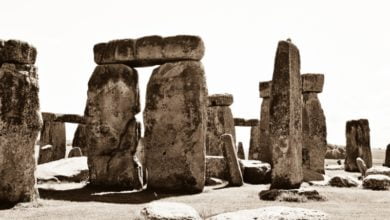
The Callanish Stones on Scotland’s Isle of Lewis have existed for about 5,000 years, stone megaliths that continue to draw visitors from around the world.
Like many of Earth’s prehistoric monuments, however, we know very little about their true purpose.
We do know that the stones were placed around 3,000 BC. We believe they were used, like other such monuments, as an astronomical calendar system, and later as a burial place.
However, what’s truly curious is that the Callanish Stones were abandoned about 1,000 years later, and buried in peat until around 1857.
Why was it built? Why was it abandoned? Yet again, we are faced with a reminder of the vast river of time that separates us from our ever mysterious past.
Scotland’s Stonehenge

These megaliths of the Outer Hebrides (or the Western Isles of Scotland) are actually broken up into multiple segments. The most popular is known as Callanish I, a crude circle comprised of 13 primary stones.
Together, the scattered stones appear to form a Celtic cross.

Due to Callanish I’s circular layout — the “center” of the cross — it’s come to be known as “Scotland’s Stonehenge.” This despite the fact that, all told, the stone monument likely predates England’s own mysterious circle by at least a few hundred years.
Today, you can often visit the Callanish Stones without anyone else in sight.
Completely alone.
You can venture right up to them, undisturbed, and place your hands on a monument that has stood longer than the Great Pyramid of Giza. Compare this to Stonehenge, which in recent years has been roped off and/or littered with tourists.
While there’s now, of course, an information center and gift shop, if their timing is just right (early morning or at the end of the day), it’s not unusual for visitors to have the prehistoric Callanish Stones all to themselves.
The Myths Of The Callanish Stones

A word of warning, however, from one reviewer over at Trip Advisor:
“If you touch them be careful if you are psychic – one of the women in our group who put her hand on one for a short time, with closed eyes, ‘saw’ men with black hoods over their heads. She also said that she had a sense of ‘evil’ surrounding her.”
Legend has it that giants used to roam the Isle of Lewis. But when St. Kieran arrived and attempted to convert them to Christianity, they refused. In punishment, the giants were turned to stone, condemned to stand forever in the shape of the cross, to watch the stars rise and fall for eternity.
Another legend tells of “the shining one,” a mysterious figure, bright as the moon, that roams the stone avenues at midsummer dawn.
These stories are likely just folklore, but we’ll never know the true purpose of these stone megaliths, or what strange rituals were performed around them.

